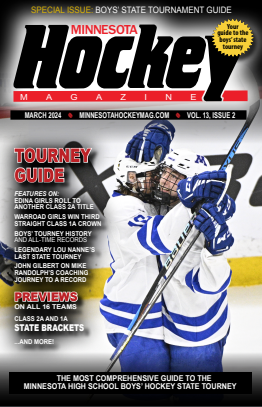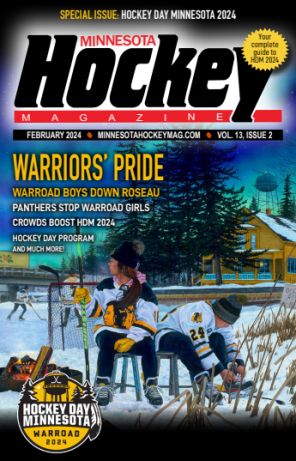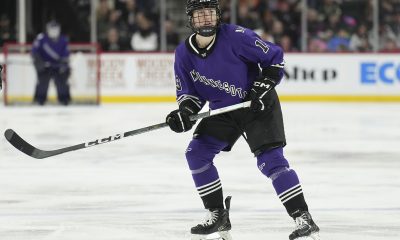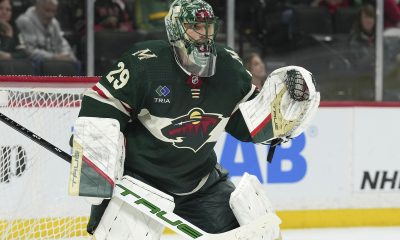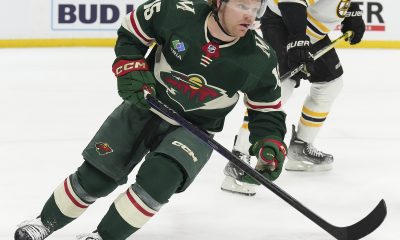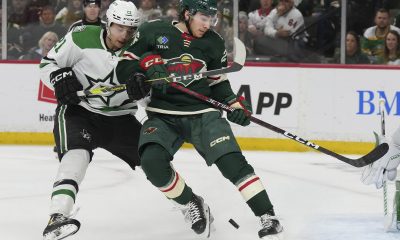Pro
Concussions Part 3 – NHL Players, Officials and Broadcasters Speak out on Concussions
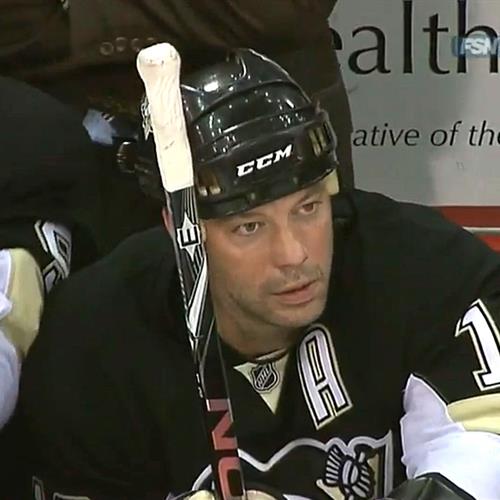
Views and opinions on concussions and the impact it has on the game with NHL players, NHL officials and NHL broadcasters.
Featured Picture: Bill Guerin, Pittsburgh Penguins
Interviews with Players, Officials, Broadcasters in the NHL:
In this final part of the research, I spoke with many involved in the game of hockey. In part three, I let them tell me their thoughts, and what needs to be done to improve safety in the game of hockey for head injuries. They felt that the NHL was making changes but you can always make more to enhance the safety of the work place for all involved. Here are their thoughts on concussions in hockey.
Tripp Tracy: former Harvard Goalie, Carolina Hurricanes Broadcaster
Like most industries, the NHL needs to make changes; it might be in better form fitting equipment. One question do you sacrifice protection of body because of head injuries? One interesting aspect that Tripp talked about was the following. When Tripp was growing up in Michigan he played against, Eric Lindros, who played in the NHL and was considered by many to be a superstar level player. One big issue Eric carried with him during his climb to the NHL was that he always skated with his head down while stick handling the puck during games. When Eric played at the youth level could get away with it, because of his size. He was much taller and heavier than the kids he played against growing up. However, when he reached the NHL, old habits are hard to break. Case of coaching on the way up to the NHL and parents not addressing the situation with him. He still skating with head down, got drilled a few times, needed to learn to skate with head up on puck control. He had to learn the risks with skating with head down with carrying the puck.
Players are fair game when coming through neutral ice with head down, you should know better as a forward or player.
Tripp stated that he would still play hockey knowing the risks involved with the game of ice hockey.
Jason Karmanos: Assistant General Manager, Carolina Hurricanes;
Big factor, size of player, dramatic size shift, more mass and speed plays a big part of it.
Elbow pads and shoulder pads), elbow pads need softer padding. Materials and manufacturing of equipment specs defined in rulebook of NHL. Each team in the league with equipment managers need to follow the guidelines carefully. League operates spot checks on equipment to adhere to codes on equipment, can happen at any time during the season.
Lack of respect by some players in the game today. College you get some no calls on stick to face because of the cages, In NHL those calls would be made. Open ice hits, need to be aware of what could happen, more vulnerable against the boards.
Rushing up ice, not much in the way of open ice hits, need to be aware of surroundings.
Do away with touch up icing or you have to shoot puck from behind own blue line, instead of center red
Helmets do breakdown over time. Need to be replaced. Helmet designs have not really changed in about 25 years.
Jason would play the game again knowing the risks; Jason had 6 concussions in his career. Vision problems, dizzy, foggy, last one he had vomiting. No concerns about his concussions on long-term health.
When it comes to goalies they are fair game outside a certain distance from the goal. Tripp said they should be allowed to play the puck outside of the crease. He feels it would take away some of the issues with players getting hit on defense.
Good puck handling goalies are very rare. They need to learn the skill. Brodeur, Hextall, Roy, are just a few who are amazing at it. A good puck-handling goalie can add years to a defenseman’s career.
Scott Stevens: Washington Capitals, St. Louis Blues, New Jersey Devils:
“I think hitting is a big part of the game and we have to be careful we don’t go too far and, you know, make the game just a finesse game, just a skating game,” Stevens said. “I think people like the physical part of this game and we don’t want to lose that.”
While noting that suspensions are certainly warranted for players who go over the line, Stevens said he didn’t think more rules were the answer.
“That’s the way I feel because I think we’ve made a lot of rule changes already, and I think we’ve taken a fair bit of the physical part of the game away already,” Stevens said. “So I wouldn’t want to see any more of that.”
Jeff Buekeboom: Edmonton Oilers, New York Rangers:
Helmet’s and sticks are not much of the issue; it is the hits from behind and not protecting oneself when playing the puck. The example Jeff gave: was when a player gets a puck and is taught to protect it by putting between themselves and boards. The natural tendency is to turn towards the boards with back to play, and the opposing player hits from behind, which causes an injury to player protecting puck. In OHL where he is coaching now, a player who delivers a headshot gets serious suspensions; NHL is not as great, when it comes to penalties for headshots. However, there are those who will tell you, that in the NHL you know the risks involved with the game and know as a player what you are getting into. You’re an adult, and you know the risks involved with the NHL. The culture of new and better equipment for kids: means that today, every youth player has to have the latest and greatest piece of equipment. Kids are wearing the best of everything, and they look like storm troopers on the ice.
If a player gets hit with head down coming across the ice, he knows the risks and dangers of coming across the ice with the head down. Inherent risks for players in the game of hockey at the NHL level.
Time and space on the ice are smaller. Big players and smaller ice surface. Game is now broken down into zones and areas and the whole ice does not get used. Creates a lot of 3 on 3 and 4 on 3 situations moving up ice. So with that many players’ hits are going to be more frequent on the ice. Neutral zone is too bottled up with bodies.
Not as many open ice hits, defenseman tend to stay back more and concede to forwards the blue line and then when they come into the zone deeper, they go to confront the player and that is when the player with the puck turns towards the boards and gets hit from behind in the corner or along the dasher boards, sometimes causing injuries.
Need to have better and more current information for players, parents, coaches, doctors, and hockey officials on the affects of concussions and headshots. Information today is sometimes old and outdated.
If you took away a line in hockey and skated with 3 lines and 3 defense pairings would not really help. Shifts would be quicker and lead to more injuries with players trying to always change lines.
Kids need to know about the vulnerability of concussions and what happens with progressions with them.
Jeff’s first concussion in the NHL was when he was 19 years old and was sucker punched in training camp during a scrimmage.
Jeff has long-term effects from the concussions he suffered from his playing days in the NHL. He informed me that he has to write everything down. Is it a symptom of old age? Who knows? He also said he has trouble with vision once in a while.
He joked and said he would play again in heartbeat because he knows how to avoid the hits he took during his playing days.
Jim Dowd: 19 year NHL veteran:
Elbow hits to the head appear much more frequently in kids in the youth level of play. Basic skills are not being taught, which includes skating, passing, and shooting. Young players need learn to always skate with their heads up at all times, and they need to know about their surroundings when on the ice. There is less hitting today in NHL, and when hitting and checking happen, it usually is very violent in the older NHL game, there was more hitting but it was not as violent as current hitting. It is critical to learn to properly hit with shoulders or hip, and note that elbows are very dangerous. The player should never hit from behind, since it is very dangerous for both players, with a greater risk of injury.
Jim Dowd introduces checking in the last month of the season which is right before the players move up to the next level of play, Mites to Pee Wee. The coaches should introduce certain techniques to kids when it comes to checking and hitting. The game of hockey is physical, and not much in the way of the physical part is being taught.
Should the coaches let the mites and squirts hit each other? They are not that big, and are all the same size, and they spend most of the time falling on the ice. Defensemen need to learn how to turn body sideways to absorb the check, and they need to learn that they should not have body-facing boards. Opposing players need to learn to pull up when hitting someone with his or her back turned on them. In previous years, players used to be able to wrap an arm around player and make the check, however that is now considered holding. This makes checking from behind more dangerous.
Equipment needs to be smaller and more form fitting. It is way too big on some kids and becomes a weapon. Some equipment, shoulder and elbow pad, for example are like cement blocks on kids and can do a great deal of harm.
Jim feels that forwards who are back checking should be allowed to impede the forwards in neutral ice a little bit, need to fight through checks; it is putting defensemen in a dangerous position to get checked. He said they should not be allowed to grab them or use stick but be allowed to bump them with a check or shadow them so they are aware the other team is there. However, not tie someone up so much they can’t move. Just enough to slow up a stride or two. Players need to learn to finish checks better and not drill someone but let them know your there for the game.
NHL created a monster by taking out center red line for speed. Let forwards fight a little coming through neutral ice.
Stop watching film and telling everyone about position. Way too much time being spent in team meetings and analyzing everything. When mistakes and breakdowns happen, that is when scoring can happen. If a team plays defense too well, scoring is down. Let the human side of the game come through.
1st shift of every game, coaches always said hit or be hit.
Removal of the 4th line in NHL is not a great concept to make a more skill game. Look at the 4th line; they are important to the success of the team winning when it comes to the playoffs. Last 10 Stanley Cup winners 3 centers and 4 sets of wingers make the difference.
Don’t admire your pass or play in the NHL or you get creamed.
Jason Zent, Philadelphia Flyers/Ottawa Senators:
Teaching kids right and wrong on when a hit is legal is certainly helpful but the best coaching education is teaching coaches what to look for if a player suffers a concussion and what to do. The real risk is for a player who suffers a concussion and the coach puts him at risk by still putting him back on the ice. Elbow pads and shoulder pads where designed to protect those specific areas of the body, but now they can be used as a weapon to the head. I would agree that all the equipment because of technology has gotten stronger and lighter. The strength of the equipment has little give to it and not to mention helps players increase the speed at which they play which contributes to concussions as well. Hits from behind when a player is in a vulnerable position are a big issue. The player who is going to hit a player with back turned seems to not “pull up” on speed when it comes to delivering hit. This is definitely a problem, and is something that is being addressed at every level. These types of hits are trying to be eliminated from the game. Unfortunately, with the speeds and nature of the game they sometimes happen without intention. Helmets and cages in youth hockey have a role in protecting the players, but players don’t seem to control their sticks as much or feel that if they hit someone they will not injury that player because of equipment? The lack of respect among players is something that also needs to be addressed. That has been an argument that has been around for some time and certainly has validity. I played college hockey and when I turned pro it was very different with that exact issue of respect. When you play without a face mask it makes you more aware of what you are doing.
Goalies are not playing the puck much in the NHL; players chasing after the puck in their defensive zone can get hurt more easily? I don’t think so. I think they learn to minimize what they deal with by playing so much. Every position has ample opportunity to be on the receiving end of a big hit and you learn how to protect yourself. I would say the risk is equal for any position.
Icings in NHL have to be touched up, how many times does a player get hit from behind or fall into dasher boards? Does something as simple of this add to the problem of concussions on players? I am sure that this would reduce a few every year. I don’t see this happening though.
With taking out the center red line in the NHL and most levels of hockey do not have center red line in play. Forwards are moving faster in neutral ice and getting hit at blue lines by defensemen on hard checks. Player’s heads down looking at pass. How vulnerable are they? Also, open ice hits in regards to the neutral zone trap? Players coming through the middle of the ice get hit while trying to play the puck. Again, I am not sure that either one has a direct impact on the number of concussions every year but I would think taking out the red line may contribute in theory because of the extra space thus allowing you to gain more speed through the neutral zone. I think the biggest problem is the hits you don’t see coming and that can happen in any style of play or place on the ice.
Taking away the fourth line in the NHL for teams and only carried nine forwards and six defenseman. Shifts would have to be longer and players would have to play a more skill game to conserve energy. One could argue they would be more tired and thus more prone to injury including head injuries. Taking players away will never happen because of the NHLPA and making the rinks bigger like Olympic sized will never happen because of the owners because that eliminates revenue for them.
Jason Zent’s personal effects from concussions:
What happened to you when you received your concussion? When you are diagnosed with a concussion it is a mandatory 7 days of not playing. For the first couple of days you do nothing that would get your heart rate up and you are monitored at night during sleeping. In order to be cleared to play you need to reach your baseline testing which is done in training camp. I was a rookie in 1995 and we did the baseline in training camp similar to what the NHL is doing. The NHL has done a very good job with this. I am not saying it’s perfect but they certainly addressed it a long time ago compared to other sports.
Any long term affects from it? Without question. I have trouble with short-term memory issues as well as noise really bothering me.
Did you go right back to playing, even though you had a concussion? No.
Did you suffer from noise issues, light sensitivity, or concentration problems? I suffered from noise and memory issues. They are getting worse as I get older.
Are you concerned for your health, as you get older? Without question! As I mentioned things have gotten worse for me. When I was playing I never really had any major issues except for right around the injury as it happened. Things seemed to go away and not bother me. Today though it seems like I am having some problems with it. The more I read the more I am concerned with things like Alzheimer, Parkinson’s etc…
You know the risks in playing hockey at a high level of competition, would you do it again? Without question yes. It was a dream of mine since I was a little kid to play in the NHL. I wouldn’t want to have not chased my dream because something bad might happen.
Mark Askin, Senior Producer, “Sports and Entertainment Television Legend”, Leafs TV:
Watch an older game from the 1950’s and 1960’s, no helmets, and not many players lying prone on the ice. Much more respect between players in this era of play. Players in today’s game look like they are wearing a suit of armor. Hit or be hit by someone who stands at 6’ 6” and weighs 240 pounds and see what happens to you.
Protection of players is very important for the NHL they are the biggest asset in the league. Players seem to launch into each other on the ice during the game. Looks like they are going after each other and head hunting. More checking with elbows and sticks during the game.
Stick control, does not carry much to the NHL. You are an adult and by the time you reach the NHL you should know what you are doing and should be responsible for your actions. When you strike someone with your stick you are aware of what you are doing. Same as when you use shoulder or elbow to check someone in a vulnerable position.
Goalies should be allowed to play the puck, speed from the forwards because of the removal of the center red, the forwards are bearing down on the defenseman, puts them in a dangerous position.
Kerry Fraser, NHL Referee, 37 years of service:
Need to have zero tolerance when it comes to headshots. Elbow and shoulder pads are now weapons and do protect players but also can injury-opposing players. There is a tremendous lack of “respect” for opponents by players, almost a disregard between players. Finishing checks, your objective as a player when you are going to check a player is to separate a player from the puck, not to drill them through the boards or knock them out on an open ice hit. Players at this level should not get themselves into a vulnerable position; as well players should not check players who has gotten themselves into a position where they can’t protect themselves.
The NHL is the pinnacle of the hockey world. They need to set the tone when it comes to head shots and other infractions in league play. If you want to eliminate head shots the penalties have to be stiff. You can send players a message with tougher penalties for head shots. Owners should be up in arms with subject; their greatest asset is in danger in the work place. Usually in these types of situations someone of star quality needs to get hurt to make the changes that are warranted.
To touch on the Eric Lindros situation which Tripp Tracy addressed earlier. When Kerry refereed Eric’s first game in the NHL, Kerry’s dad was at the game and asked him what he thought about Lindros play? Kerry said to his father, “He is going to be a great player; I just hope he can survive with the way he plays.”
Kerry feels the one question that needs to be asked; does the NHL have responsibility in the work place to keep its employees, mainly the players in a safe environment? They are the biggest assets in the business model for the NHL. Kerry also feels as a referee in the NHL, he has a duty and responsibility to keep the players safe and in a fair manner in accordance with the rules of the NHL. Also, he feels he must keep the game moving and make sure it is entertaining for the fans of the NHL.
Dana Heinze, Equipment Specialist, Pittsburgh Penguins:
Mid 1990’s equipment changed and players increase dramatically in size. In 2002-2003 season the NHL made it mandatory for soft caps on elbow pads. When he was the assistant equipment manager for the Tampa Bay Lightning, Martin St. Louis who plays for the team was still using the same shoulder pads he wore when he was playing junior hockey in Canada. Dana said most players are creatures of habit when it comes to equipment. They also have the mirror test when it comes to equipment, if it does not look good they won’t wear it.
Things that Dana would never do for a player is to modify a piece of equipment, especially helmets. He was asked by players when with other clubs if he would make some changes to them. He flatly refused. All helmets when they are issued to him with the Penguins, they have two stickers on them which certify that they are safe, HECC in United States and CSA in Canada. If these stickers are taken off the helmet at the amateur level the helmet loses it certification that it is safe.
All players on the Pittsburgh Penguins have certain rules they follow when it comes to equipment and helmets which comes directly from the owner, general manager, there are certain guidelines that the NHL has set up and Dana follows them along with other guidelines that the Penguins have. He brought up issues of the gloves, they will not issue a 13 inch cuffed glove. It offers no protection of the wrist for the players. All players must wear 14 inches or larger.
He informed about wearing shields in the NHL. Sidney Crosby one time told him that the reason why he wears a shield is so he does not break his mom’s heart when it comes to safety. Dana feels that as a player’s progress toward the NHL, coaches and parents can have a big influence on young players when it comes to equipment. With Sid you can see that his mother had a great influence on his safety as a hockey player.
The reason why manufacturers of equipment started using plastic on caps for elbows and shoulder pads was twofold. The first reason was it cost effective to manufacture and second it offered greater protect for the players. With that being said it, elbows and shoulders started becoming weapons. They need to offer protection on both sides of the puck.
Bob McGill, Chicago Blackhawks, San Jose Sharks, Detroit Red Wings, Toronto Maple Leafs:
Bob feels with bigger and faster players injuries will increase, only natural with the size and speed of today’s game at the NHL level. Equipment is the biggest problem, elbow pads and shoulder pads are weapons on players today. They offer to protect the player but can also injury others on the ice.
When Bob played in the in the NHL as a defenseman, he wanted to hurt the opposing player when he checked them coming down on his side. By that he meant not to take them out of the game but to send a message that he was on the ice and ready to play. In the NHL you’re going to get hit and checked during play, be ready for it, it is part of the game. Skating with head down and carrying the puck, all the players know this is not part of the game. As a player in the NHL you should be aware of this, as Bob said you are fair game. Jim Dowd also stated that in the NHL don’t ever admire your play or pass; you’re going to get creamed by an opposing player.
First time Bob suffered a concussion, just kept playing, and did not want to lose his job in the NHL. Another time Wendell Clark hit him practice with his shoulder, he woke up with the team standing over him. He got up went the bench grabbed a drink and went right back into practice.
Bob feels with all the research today for symptoms for concussions, some of the younger players use it as a crutch as it were to not go back into the action of the game or practice.
Jack Edwards, Boston Bruins, NESN Broadcaster:
Speed and size biggest part. More open ice for the players to use. Much stronger and in better shape. In the sense of kids, way too many games. Not paying attention to skill development of young players. Rushing them along in their development. Way too much travel at the age of 11-12 years of age. To travel two hours to play 16 minutes in a game and then to drive back two hours does nothing for the development of young players. Four hours of travel time and 16 minutes of play is a waste. Could have the younger players stay at home rink and play for two hours in a pick up or house league game, with a practice. Play more pickup games with friends and less time with someone with a clipboard and whistle.
Parents are more interested in goals, assists, and winning. The way the system is set up kids wind up with lousy skills and poor conditioning. They are over programmed and they don’t learn game and it nuances. Maybe travel once or twice a year to a big tournament. Let them learn to play the game on their own. Stop telling them everything. Let them think for themselves. Create a safe and fun environment for them. How do you think Bossy, Lafleur, Gretzky, Howe, Potvin, Orr, Crosby, Lemieux, got so good? Playing with friends and learning the game.
Elbows and shoulders: Somewhere along the way it probably became cheaper to make shoulder and elbow pads from hard plastic. NHL officials have to get tougher on hits to head and what happens on the ice. Trapezoid, out, goalies are fairgame outside the crease. Touch up icings stay in the game. Skating with head down is a big no in the NHL.
Rushing players to the NHL before they are ready. Great example a few seasons ago, Brandon Sutter, rushed to the NHL, GM’s feel pressure to bring players up to the NHL because of the salary issue. Want to increase the level of play in the NHL, get rid of six teams. Skill level will increase and the cheap stuff will not be as prevalent. Danny Gare played on a checking line and was a 50 goal scorer. Don’t see anyone come close to that today on a checking line. Playing 82 games in 184 days creates danger for the players. Averages out to 2.3 games a day played. Players are being pushed too hard. Injuries are going to happen to players more often.
Craig Laughlin, Washington Capitals:
Size does come into play today in the NHL; it is more lack of respect between players on the ice. When I played and a player was going to hit you from behind he pulled up more and grabbed you to make the hit. Today they finish their check and drive you through the boards.
In the 1970’s and 1980’s shoulder pads and elbow guards not as big. In some cases players only wore shoulder caps and no protection on chest area. More open ice hits in the 70’s and 80’s. They were hard but you were not in a vulnerable position when hit. Dasher boards and glass much harder and not much give when you hit them in today’s game. Chances for injury are greater. Seamless glass good for fans and television but very dangerous for the players. They should have the boards and glass with springs or some give when players hit them.
On the question of less players on the roster to make the skill of the game more important and the players have to conserve some energy, answer is no. From 1981-83 there were 11 forwards and 6 defenseman on an NHL roster. Game was still tough and rough. Yes to automatic icings. Too much can go wrong when players are chasing down a puck. Lose the trapezoid, let goalie play the puck more. With goalies not allowed to play puck defenseman racing back to play puck they get hit more on dump in’s by the attacking team.
Design a helmet like the Messier helmet or some type of extra devise under the helmet to protect the skull and absorb the hit and displace the energy over a larger area of the skull and not so concentrated to one spot.
Hits from behind. There should be stiffer penalties.
4 minute double minor at the discretion of the officials
5 minute major if player is injured on the play and he can’t leave the ice under own power
1st time on a 5 minute major hit from behind suspended 3 games automatic, 2nd time 5 games with monetary fine, 3rd time 10 games, monetary fine, and league revue.
He also felt players have to stop turning their backs to the play when holding the puck; it puts them in a very dangerous position to get hurt.
Chris Therien, Philadelphia Flyers:
Skating and speed are much greater in the past few seasons post lockout. Forwards should be allowed to fight through checks a little bit in neutral ice. Should be allowed to hand check a player or shadow him a little more. Defenseman need to learn to protect themselves and turn with the check. Very little in the way of respect or accountability among players today in NHL. If you take away 4th line, setting yourself up for injuries to your top lines. Only removing about $1.5 million in salary to risk injury to $15 to $18 million in another star. Not very good for teams.
His symptoms on his first concussion, head got hit, and then head hit boards and then a face plant on the ice. John LeClair stood over him trying to talk to him and he could not make out anything he was saying at the time. Three times his head got hit on the play. Was out 10-12 days. Last concussion which was his 7th, dizzy, sick, never played again, 8 months of no driving, dark rooms, vomiting a lot, light really bothered him, still today has headaches and focusing problems. Hate to say but, played because the money was too good to pass up. Would play again, no regrets. Does not worry about the long-term effects from what he suffered. Just loves the game of hockey.
Steve Coates, Philadelphia Flyers Broadcaster:
In 1979 when the helmet rule became mandatory for new players it started to become a target for opposing players. Players felt if they were wearing helmets not as much regard for their elbows, shoulders, and sticks, when checking a player.
Steve would like to see the instigator rule taken away from the game. More players would know if they committed an action during the game and injured a player, they would then have a target on their backs.
He suffered a skull fracture during his career and has no permanent affects from the injury.
Bobby “Chief” Taylor, Philadelphia Flyers, Tampa Bay Lighting Broadcaster:
Bobby feels the bigger equipment is a major factor to the head injury rate. Shoulder pads and elbow guards which are meant to protect that area of the players are now weapons against opposing players. He feels that kids need to be taught how to play the game correctly and more basic skills to be worked on. They have no fear in the youth game today because of helmets and cages, need to learn responsibilities for their actions.
Players at all levels, especially the NHL, need to know how to turn away from the hits that are coming their way. NHL players also need to be aware of their surroundings on the ice at all times. Bobby also went on to say that with some of the rules changes, they have taken away safety to gain more speed on the ice. The instigator rule leaves your star players and smaller players more at risk. You can’t have an enforcer protect them because of the rule that the penalty carries.
No trapezoid, only put into the game for one goalie, Martin Brodeur, because he is a good puck-handling goalie. What the trapezoid does now is make it more dangerous for defensemen coming back into the zone to play the puck. A good puck-handling goalie can add years to a defenseman’s career. Just ask Ken Daneyko who played with Martin Brodeur.
Terry Crisp, Former Tampa Bay Lightning Coach, Nashville Predators Broadcaster:
Terry feels like others in the game equipment is too big, bulky. Does contribute to the injury rate in players. When he played he worn shoulder caps and not much else on upper body. You did hit players but it was to separate them from the puck, not drive them through the boards. Need to focus on how to avoid hits and not put self in vulnerable positions on the ice.
The respect factor is gone in the game. Terry talked about when you injured another player when you played and returned to the bench, your teammates would let you have it. They would get on you about injuring the other player and now it was going to be a problem on the ice. Need accountability.
Keep sticks and elbows down when hitting another player, he did it and so did a lot of other players when he played. Joked that Gordie Howe was one of the few who could get away with the elbow hits, could take care of himself on the ice.
Bill Guerin, Pittsburgh Penguins:
“If a guy gets hurt like that with a shot to the head, there’s got to be something,” Guerin said. “Actions happen. Guys don’t mean to hurt each other, but they do. You got to pay a price for that.” Guerin said players must know they can play the game with protection against hits to the head, especially those that a player can’t see coming.” We’re all under the same umbrella, whether the guy’s on my team and I’m sitting right next to him or he’s playing in California,” Guerin said. “It doesn’t matter. We’re all playing in the same league. We all want the same safety. We all want to be looked after the same way.
Nick Kypreos, Toronto Maple Leafs, New York Rangers, Washington Capitals, Hartford Whalers:
Nick had suffered multiple concussions in his career and felt he no longer needed to take continued risk of playing in the NHL. I had to think of my future. I was considered a role player, a physical player and I knew there were consequences.
“You give your lumps, you take your lumps.” Nick Kypreos didn’t count on the career-ending concussion he suffered in a fight during an exhibition game against the New York Rangers. “I lost my helmet and hit my head on the ice. It’s like a dream you can’t remember. Within one hour everything started to come back into focus. I was being asked how I was feeling and if I could go back on the ice to finish the game.”
Players should not be asked that question. ‘They’re too emotional to answer. You just want everyone to forget it ever happened…to keep playing hockey. Since I was seven-years-old, I’ve been told to ‘shake it off’, “dust off the cobwebs”, “suck it up” and you’ll be fine. Unfortunately he found out that that is not always true. ‘The days of sniffing smelling salts are over’, he said. “You can see a knee or a shoulder injury but you can’t see a head injury, so there is always the question of ‘how hurt is he?” Only a doctor should decide when the player can return to the game.’ Nick Kypreos says team officials must learn how to recognize a concussion and there should be a specific protocol to follow when any player is injured.
Pat LaFontaine, New York Islanders, Buffalo Sabres, New York Rangers:
Players from 11-13 years of age need to work on basic skills, spending more time on skating, shooting, passing, and game strategies. These skills will make the younger player better and enjoy playing more.The players in the 5 to 11 year age range have skills that are okay, but they should bump each other because they can do little harm to each other since they are all the same size and spend most of the time falling to the ice.
The emphasis at 12 years of age focuses on hitting and checking when it should be about skills and skating. Too much time spent on the hitting aspects of the game. The problem with this many but the big one Pat sees is that when players start work on checking in a game, the size factor between players can be large. You can have a 12 year old player who has had a growth spurt and could have a large size advantage over the other players on the ice. This can be dangerous if another player has not had a growth spurt and his or her skills are not as strong as the other players.
The coaches should work on skill levels and teach kids to take checks better and work with them on all aspects of the game. It is important to take away neck and head shots as well as, hits from behind on a player. Suspensions of players for such hits should be implemented. However players need to learn not to turn back on the play when carrying puck.
Conclusion:
This research for the issue of concussions in the NHL has been an amazing subject for me. It opened my eyes to a great many things in the game of hockey. I have a deep passion for the game. Outside of my wife and children it is one of the most important things in my life and one constant I have always had since I was five years of age.
Do I like a physical game, yes? Do I enjoy hitting and rough play, absolutely; it is what separates hockey from all other sports. It is one of the few team sports where you generate your own speed on razor thin blades and fly up the ice. It is an amazing feeling.
Do I enjoy the fighting and does it have a place in the game. When you play the game and you know that a player who is an “enforcer” is in the game it always is in the back of your mind to watch what you do when out on ice. Don’t take liberties with the best player on the other team or you will pay? This is why the instigator rule in my opinion needs to be removed from the game, it would slow down the cheap shots from other players. Right now players know if they do something that they won’t have to answer the bell right after the play. If the rule is removed they might later in the game.
The one part of the game that was stressed to me by the people who I interviewed was always keep your head up and know your surroundings on the ice at all times. Skating with your head down according to the players is a big no no. You’re inviting problems to yourself when skating with your head down on the ice. You’re a target. All of the people said head up and know your surroundings and you won’t have any problems
I do feel, the NHL does have a responsibility to its players on the ice. They need to have a safe work environment like all industries. They are the biggest asset for the league. Without the players there is no NHL. I don’t mean to coddle them but give them some protection.





